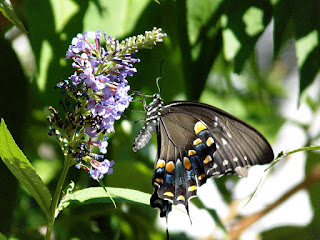From the UNIVERSITY OF EAST ANGLIA and the department of interchangeable lexicon comes this study that may have merit, except they can’t seem to decide if it is weather or climate having an effect by the way they word it.ECE also equals, oh say, weather. Sometimes its good, sometimes it's bad.
Research into extreme weather effects may explain recent butterfly decline
Researchers investigated the impact of Extreme Climatic Events (ECEs) on butterfly populations. The study shows that the impact can be significantly positive and negative, but questions remain as to whether the benefits outweigh the negative effects.
While it is well known that changes to the mean climate can affect ecosystems, little is known about the impact of short-term extreme climatic events (ECEs) such as heatwaves, heavy rainfall or droughts.
Osgur McDermott-Long, PhD student and lead author from the School of Environmental Sciences at UEA, said: “This is the first study to examine the effects of extreme climate events across all life stages of the UK butterflies from egg to adult butterfly. We wanted to identify sensitive life stages and unravel the role that life history traits play in species sensitivity to ECEs.”
 A few photos from 2016.
A few photos from 2016.The researchers used data from the UK Butterfly Monitoring Scheme (UKBMS), a high-quality long-term dataset of UK butterfly abundances collected from over 1,800 sites across the UK, spanning 37 years, to examine the effects of weather data and extreme events (drought, extremes of rain, heat and cold) on population change.As you may or may not know, one of my retirement hobbies, in addition to fishing and walking the dog, has been finding, photographing and counting species of butterflies. Last year (an El Nino year, and exceptionally warm) was also an exceptional year for butterflies, with my finding some 45 species over the course of the year (a few were in California), while this year, a ENSO neutral year, was not nearly as good in terms of number of butterflies or the number of species (only 35 to date, including California).
The team looked at resident species of butterflies, those which only breed once in a year, and those having more than one brood annually. Multi-brood species were found to be more vulnerable than single brood species and in general extremes of temperature rather than precipitation were found to influence changes in butterfly populations.
So far, in my experience, warmer years tend to be better for butterflies, although, of course, some of the species from colder areas may not be favored. Given the number of variables, the food available when their caterpillars out, the predators that eat the larvae and the adults, the prevalence of nectar (and other adult food) sources, it seems to me pretty difficult to suss out the effects of weather, climate, land use changes etc. etc.



No comments:
Post a Comment